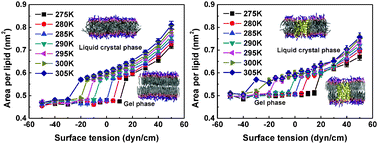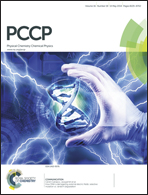Surface tension effects on the phase transition of a DPPC bilayer with and without protein: a molecular dynamics simulation†
Abstract
While the surface tension of a cell membrane, or a plasma membrane, regulates cell functions, little is known about its effect on the conformational changes of the lipid bilayer and hence the resulting changes in the cell membrane. To obtain some insights into the phase transition of the lipid bilayer as a function of surface tension, we used a 1,2-dipalmitoyl-sn-glycero-3-phosphocholine (DPPC) bilayer as a model lipid bilayer and aquaporin (AqpZ), a transmembrane channel protein for water, as a model embedded protein. A coarse-grained molecular dynamics simulation was applied to illustrate the phase transition behavior of the pure DPPC bilayer and aquaporin-embedded DPPC bilayer under different surface tensions. It was shown that an increased surface tension reduced the phase transition temperature of the DPPC bilayer. As for the DPPC bilayer in gel form, no significant changes occurred in the structure of the bilayer in response to the surface tension. Once in a liquid crystal state, both the structure and properties of the DPPC bilayer, such as area per lipid, lipid order parameters, bilayer thickness and lateral diffusion coefficients, were responsive to the magnitude of surface tension in a linear way. The presence of aquaporin attenuated the compact alignment of the lipid bilayer, hindered the parallel movement, and thus made the DPPC bilayer less sensitive to the surface tension.


 Please wait while we load your content...
Please wait while we load your content...